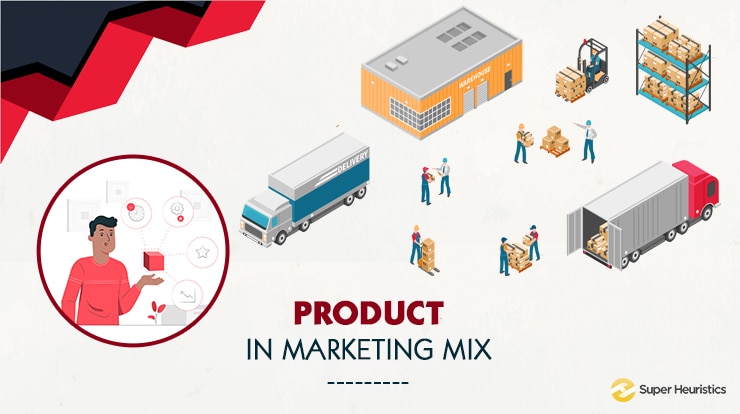
Product in marketing mix is the most fundamental topic we all learn and 4Ps of marketing is one of the first frameworks taught in the vast domain. In fact, the 4Ps and then the 7Ps of marketing, which lay the foundation for the marketing mix, must be thoroughly comprehensive to us, whether to sell a product or to contribute to other functions related to launching a product to market.
We begin our discussion with looking at the fundamental 4Ps of marketing – Product, Place, Price, and Promotion. Out of these, you will come to realize that Product in marketing mix is, probably, the most crucial component. Remember that it originates directly from your customer through an unmet need that they have.

The 4 Ps of marketing mix are Product, Place, Price and Promotion
After this conceptual understanding, I will walk you through various thoughts and frameworks associated with the ‘Product’. This will help you comprehend an entire 360-degree view of the topic. I hope that by the end of our conversation, you will hold a long-lasting clarity of what a Product in 4Ps of marketing is all about.
So, let us begin with understanding the element Product in marketing mix, and I will highlight multiple examples for you on the way to better relate the idea I want to convey.
Also, before diving deeper, let me introduce you to the agenda of our interaction.
What is a Marketing Mix?
Marketing mix includes elements of what a company offers to its customers. The term was first coined to eliminate any barriers that may come in the way of successfully adopting the offering.
But why is marketing mix important? Let us now understand the 4Ps of marketing with examples.
Compare an effective marketing mix to a recipe of your favourite dish. The description begins with enlisting all necessary ingredients needed for preparation. But it doesn’t stop here.
The recipe goes on to describe steps to blend, mix and cook these ingredients in the right proportion, at the right time, and under specific conditions to achieve the desired outcome of a finger-licking meal.
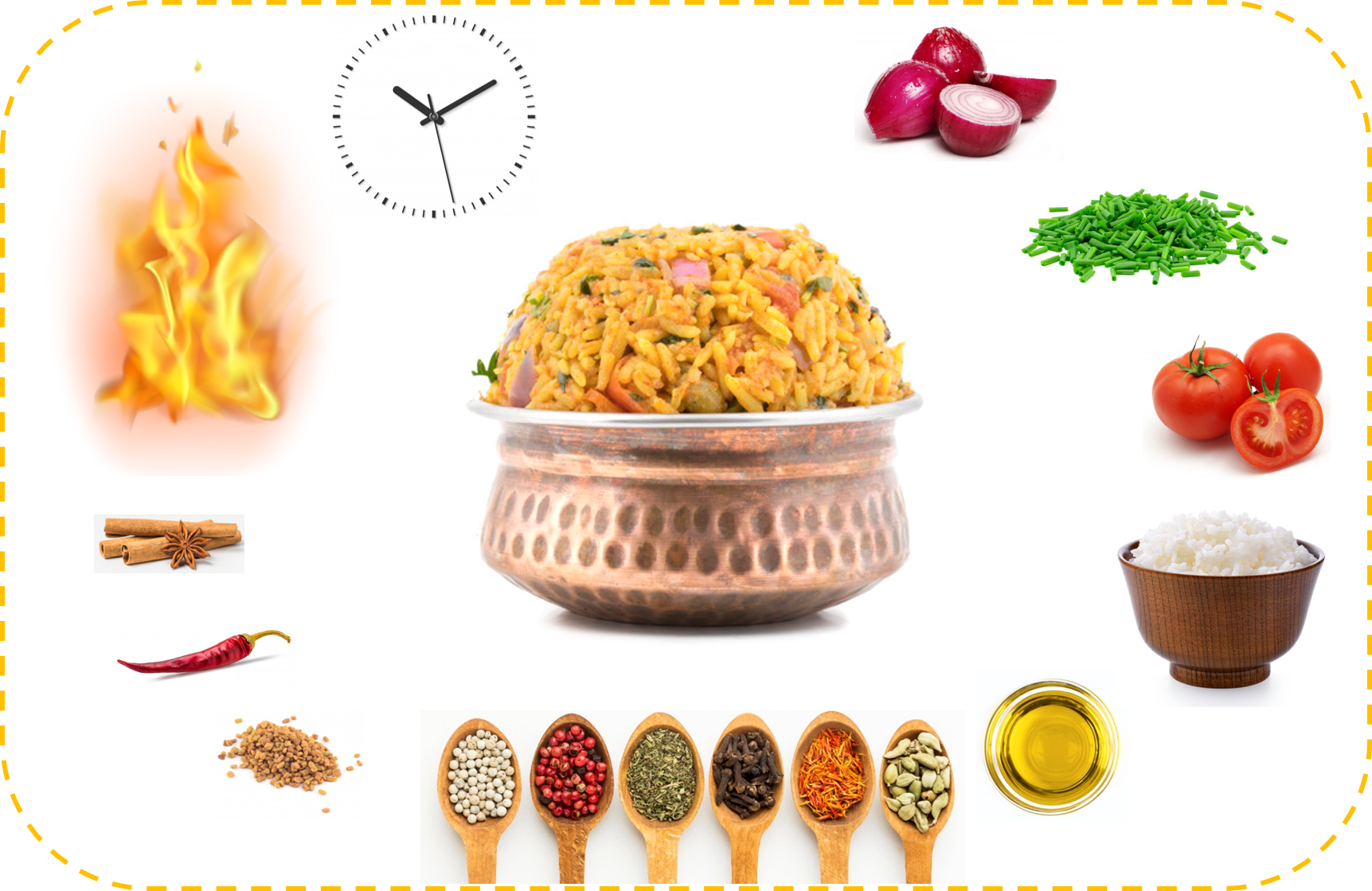
Just like preparation of your favourite biryani dish requires the right proportion of ingredients cooked together, a desirable marketing plan requires a flawless interplay between the 7 elements of the marketing mix
Just like ingredients for cooking the dish, a desirable market offering must include each of the 4Ps: Product, Place, Price, and Promotion in a well-thought out mix. These 4Ps of marketing mix will decide the direction in which your marketing campaign will go to give you an outcome. Whether desirable or not will depend upon how much of what ‘ingredient’ (in this case, element of marketing mix) you add to the preparation.
Product in 4Ps of Marketing
Let us take a moment here to appreciate how the entire concept of marketing mix is centred around the Product. Other elements, the 7 Ps of marketing, which also include People, Process, and Physical Environment are developed based on what product you plan to sell.
What is a Product?
Think of Product in marketing mix as an umbrella term that describes anything a business wants to sell to their customer (an end user or another business). Product is the entity that satisfies a customer’s need and want.
Products can be any of the following entities :
Everyday, you make choices in using various products based on their unique properties, on factors like product variety, quality, design, features, associated brand name, packaging, sizes, additional services, warranties and returns.
How can products be categorized?
At this stage, you might feel that the ‘Product’ in marketing mix is a very abstract concept. Can we group products into categories to comprehend better?
Tangible product | Intangible Product | Services |
|---|---|---|
Items have a physical presence | No physical presence | An intangible process that benefits the customer |
Sensory identification of different attributes (look and feel, appearance) | Experienced indirectly through offered features and benefits | Differ from intangible products by delivering value without giving any ownership |
|
|
|
We experience tangible products with our five senses. For example, you may flaunt your latest Bluetooth speaker’s features like sleek design, and exceptional sound quality based on the sense of vision, hearing, and touch. I like my coffee strong; the aroma and taste are testament to the product quality.
An e-book purchased on Amazon, however, is intangible but offers knowledge to buyers.
Now consider getting a haircut at your local salon. The haircut isn’t a product that you own, but you benefit from the facilities provided based on your specific needs. That is a service.
You’ll notice that businesses around you offer a combination of different varieties of products bundled into one overall offering. For instance, having a Caffé Latte at Starbucks isn’t just about the product on the menu, but the entire experience of visiting a Starbucks outlet. We’ll discuss this example in detail in a later section about meeting and exceeding customer needs through your offering.
A unique Product type
Also think about internet services we use everyday to interact and collaborate at work: Google Drive, Amazon Web Services. Or even platforms for personal use like Netflix for entertainment and Microsoft Office, a suite of client services. They’re also a unique type of products!
SaaS, software as a service is the latest break-through in the product marketing space. You virtually get every digital service via some SaaS product, from team collaboration in office to personal financing based on your family’s needs. What elements of a SaaS product do you think add value to their clients?
I am sure you are now able to appreciate the meaning and importance of product in marketing mix. We will next look at the elements that create a well-rounded product, that goes beyond offering all stated and unstated customer needs.
The Product Mix
Often, we visit stores offering a variety of products in the same location, whether physical (the supermarket) or virtual (like Amazon). The portfolio of products available are called the product mix, and available products can be grouped based on similar attributes or benefits.
Each t-shirt in an apparel store is a product unit (a unit of product), and is part of a product line, call it “T-Shirts”. So, within this section, you choose a t-shirt of your choice based on its unique variation, features, or price points, which are differentiating factors to you while making a choice.

Apparel stores offer a product mix comprising numerous product units in multiple product lines
This brings us to an interesting concept of Product Levels, based on different levels of needs customers have, and how they can be satisfied based on the 5 levels of a product being offered.
The Five Product Levels will help you answer questions like what benefits do you want to offer through your product, how will you differentiate your services from competitors, what is your product’s Unique Selling Proposition, and how to deliver superior value through the offering?
We know that every product is launched in market to meet customer needs. A need is the lack of a basic human requirement. A want (a sub-set of need) is a requirement of a specific object that can satisfy the basic need. A demand is a set of wants which, along with the desire and ability to pay, can satisfy the requirement.
The Five Product Levels Model with example
What convinces you to purchase a product? You perceive a value that the product will offer if you buy it. After you buy, if the actual value delivered exceeds your expectations, you are satisfied, but if it falls below your perceived value, you are dissatisfied. Let’s understand the model with an example:
Consider you are exhausted after a long day and want to energise yourself with a meal. Your requirement of satisfying your hunger is a fundamental need. A café offering a meal might interest you. The café offers a Core Benefit.
You receive the meal in a bowl, on a tray, with a spoon at your table to dine-in. You are satisfied and begin eating, since the café met your needs of a Generic Product.
Considering the COVID time, you wonder whether the kitchen was hygienic, and the cutlery washed with care. You are expecting additional features to be offered with the product (meal) which aren’t needed to satisfy your core need. You’ve reached the stage of Expected Product.
Now suppose the restaurant you visited for dinner is actually a renowned café, which serves different choice cuisines, along with an exceptional dining experience. The overall experience is unique and appreciated by you among the available options in the neighbourhood. The services offered are an Augmented Product.
Now suppose the café being talked about is Starbucks. Starbucks is globally known for its top-notch customer experience. Through market analysis and technology, they offer services that continue to surprise and delight you, and the expectation of superior ambience and improved service are constantly exceeded through future product (and service) improvements. Starbucks successfully offers a Potential Product, the highest level of a product in marketing mix.
Companies strive to deliver such superior value (that Starbucks offers) by spending resources and money in Product Development based on market analysis and a cost estimate (to ensure profitability).
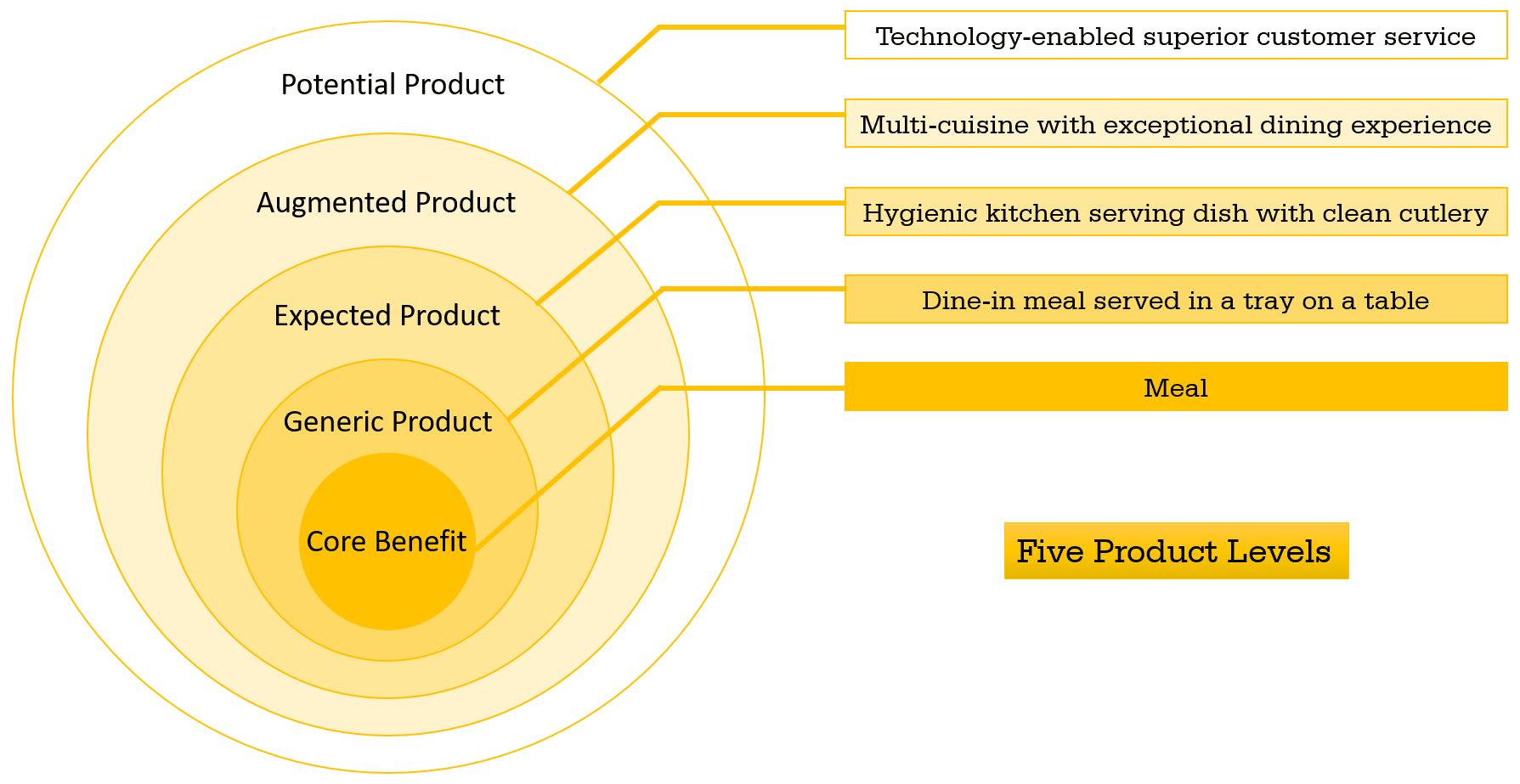
Kotler's Five Product Levels consider customer needs to determine the unique product benefit being offered
Product Lifecycle
We have covered a lot of ground today, with many concepts clearing the air around Product in marketing mix. Before concluding our discussion about Product in 4Ps of marketing, I want to briefly introduce you to a typical product lifecycle.
How the product performs in 4 stages – Introduction, Growth, Maturity, and Decline is the basis for product development and strategizing decisions. Stages are identified based on the time series plot of product sales figures.
Suppose Starbucks identifies the need to launch a new product in their cold-coffee product category.
They will Introduce the product on an official launch, with slow growth. You might get to know about the product one fine day while browsing their menu, or while viewing an advertisement. Very limited and gradual popularity among a specific section of the audience, generated by people choosing to try the new product.
The next stage, when you hear about the product through a friend who recommended you to try it, means you’re witnessing the Growth stage, with rapid and exponential sales hike, and more audience coming in through word of mouth. Product is set to enter the list of mainstream offerings as we transition to the Maturity phase.
Product gains strong foothold in market in the Maturity phase, with gradual slowdown in sales. It becomes widely available and is established as a strong competitor.
Finally, the cold-coffee no longer offers unique value to you as you begin to switch to other similar but better products or do not feel the need to have a cold-coffee. This leads to downward spiral of sales in the Decline phase with only limited saturated features and outdated value-added services offered.
While being involved in new product development, you can now comprehend the importance of realistically mapping product journey, making safe predictions, and re-designing the product if needed.
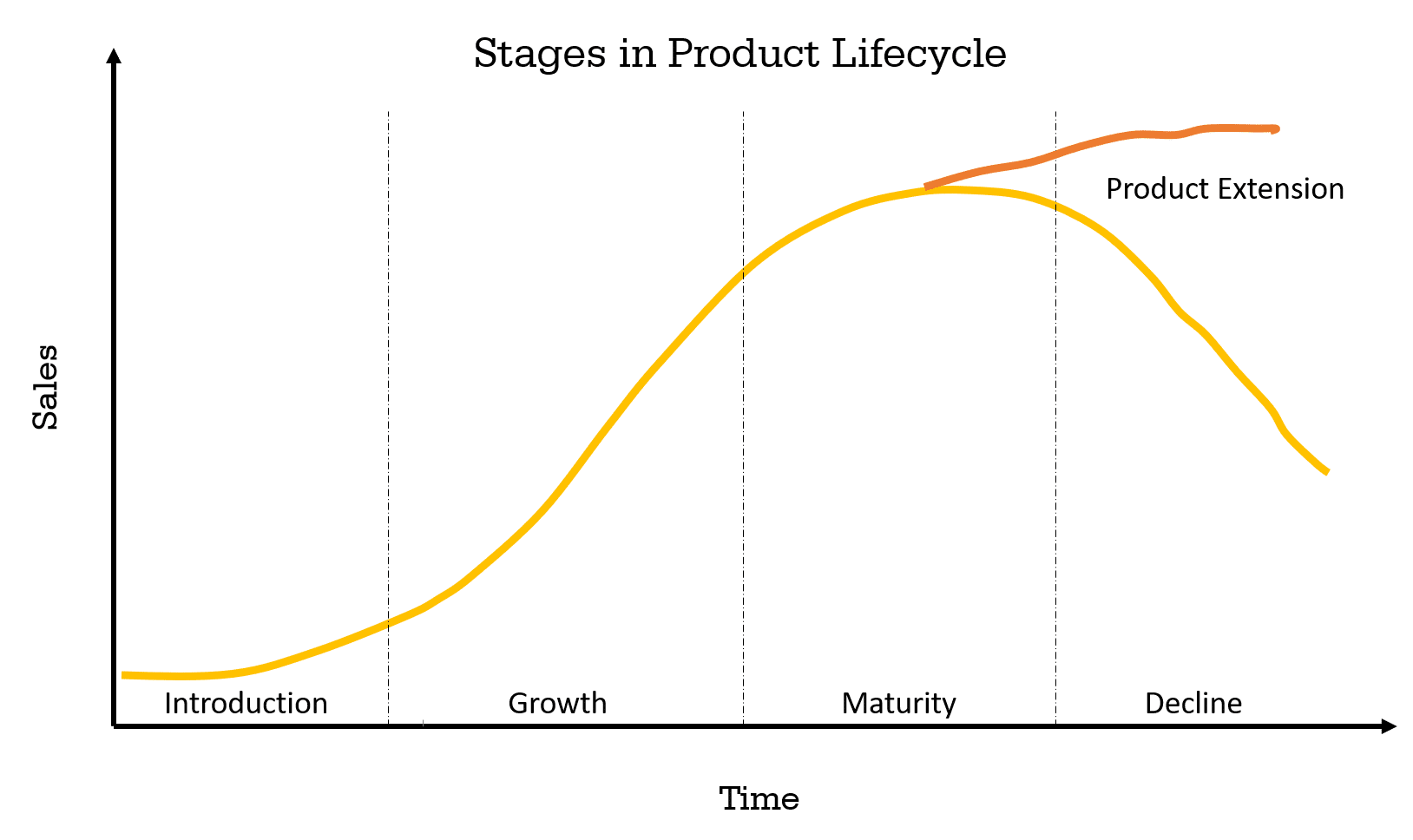
A realistic estimate of the product lifecycle can help mitigate losses and put efforts in reviving declining products that hold the potential to be extended to deliver better customer value
Find e-Book: Successful Pricing Strategies for Product Life Cycle
Conclusion
I am sure you are now confident about all aspects involving product in marketing mix, its importance, applications, and implementation frameworks to take care of. This overall view of the product in 4Ps of marketing actually helped me identify and develop a product-based marketing strategy on the basis of clear understanding of what is it that I need to sell.
I hope our discussion today was fruitful to you.
Also Read: Detailed SWOT Analysis of Apple
Also Read: Back to Basics - What really is Marketing?

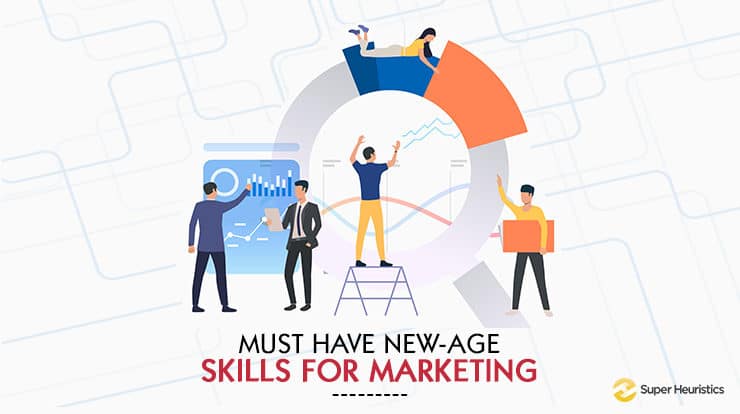



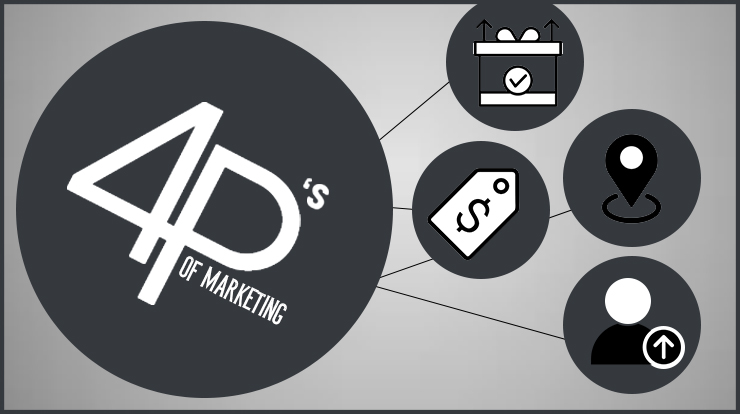


Simple and easy to understand